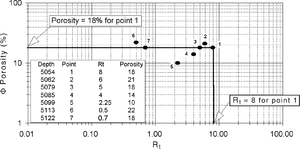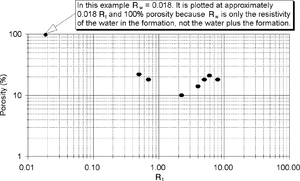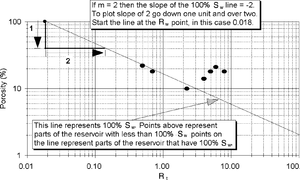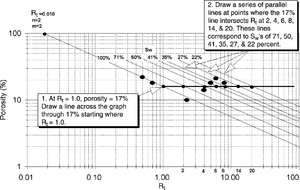Difference between revisions of "Pickett plot construction"
Cwhitehurst (talk | contribs) |
Cwhitehurst (talk | contribs) |
||
| Line 76: | Line 76: | ||
==Step 5: plot s<sub>w</sub> lines== | ==Step 5: plot s<sub>w</sub> lines== | ||
| + | |||
| + | [[file:predicting-reservoir-system-quality-and-performance_fig9-39.png|thumb|{{figure number|4}}An example of plotting the lower percentages of S<sub>w</sub>.]] | ||
| + | |||
After plotting the 100% S<sub>w</sub> line, plot the lines representing lower percentages of S<sub>w</sub> using this procedure. | After plotting the 100% S<sub>w</sub> line, plot the lines representing lower percentages of S<sub>w</sub> using this procedure. | ||
| Line 96: | Line 99: | ||
|} | |} | ||
| − | + | [[:file:predicting-reservoir-system-quality-and-performance_fig9-39.png|Figure 4]] is an example of following this procedure. | |
| − | |||
| − | [[file:predicting-reservoir-system-quality-and-performance_fig9-39.png| | ||
==See also== | ==See also== | ||
Revision as of 16:32, 6 March 2014
| Exploring for Oil and Gas Traps | |

| |
| Series | Treatise in Petroleum Geology |
|---|---|
| Part | Predicting the occurrence of oil and gas traps |
| Chapter | Predicting reservoir system quality and performance |
| Author | Dan J. Hartmann, Edward A. Beaumont |
| Link | Web page |
| Store | AAPG Store |
A Pickett plot lets us compare water saturations of different parts of a reservoir in one or many wells. The Pickett plot[1] is a visual representation of the Archie equation and therefore is a powerful graphic technique for estimating Sw ranges within a reservoir. All that is needed to make a Pickett plot is a set of porosities and corresponding resistivities taken from well logs and 2×4 cycle log-log paper. The procedure for making a Pickett plot consists of five steps, detailed below.
| Step | Action |
|---|---|
| 1 | Plot points of matching porosity and true resistivity (Rt ) on log-log paper. |
| 2 | Plot Rw point on the Rt scale. |
| 3 | Determine m using the table of values. |
| 4 | Plot the 100% Sw line. |
| 5 | Plot the lines representing lower values of Sw . |
Step 1: Plot points
Plot points of matching porosity and true resistivity (Rt) values obtained from well logs on 2×4 cycle log-log paper, as shown in Figure 1. Use the x-axis for the resistivity (Rt) scale and the y-axis for the porosity (Φ) scale.
Step 2: plot rw point
Plot the Rw value (resistivity of formation water) by plotting the Rw point along the Rt scale on the x-axis at the top of the graph grid where porosity is 100%, as shown in Figure 2. Rw values are published by logging companies, or we can calculate them from the SP log.
Step 3: Determine m
Estimate m (cementation factor) using the table below. Laboratory analysis is necessary for a precise determination of m. However, by knowing what the expected porosity type is, we can estimate the value. If you are unsure of the porosity type, use an m of 2.
| Porosity type | Value for m |
|---|---|
| Sandstones with diagenetic or detrital clay in pores | 1.7–1.8 |
| Formations with clean, macro- to micro-sized pore throats (Archie rocks) | 2 |
| Formations with vuggy porosity (touching to nontouching) | 2.2–3.0 |
Step 4: Plot the 100% Sw line
On a Pickett plot, the value of m determines the slope of the Sw lines. The first Sw line plotted on a Pickett plot is the 100% Sw line. To plot this line, draw a line with a negative slope equal to m that begins at the Rw point. Use a linear scale to measure the slope; for example, go down length::1 in. and over 2 in.
Figure 3 shows how to plot an m of 2.
Step 5: plot sw lines
After plotting the 100% Sw line, plot the lines representing lower percentages of Sw using this procedure.
| Step | Action |
|---|---|
| 1 | Find the intercept of Rt = 1 and the 100% Sw line (made in the last procedure). |
| 2 | From this intercept, draw a line parallel to the x-axis across the plot. Any point on this line has the same porosity. |
| 3 | Where this line passes through Rt of 2, 4, 6, 8, 14, and 20, draw a series of lines parallel to the 100% Sw line. |
| 4 | Points on these lines correspond to Sw of 71, 50, 41, 35, 27, and 22%. These percentages are calculated from the Archie equation using m = 2 and n = 2 at Rt of 2, 4, 6, 8, 14, and 20. |
Figure 4 is an example of following this procedure.
See also
- Determining water saturation
- Calculating Sw from the Archie equation
- Determining Rt
- Calculating Rw from SP logs
References
- ↑ Pickett, G., R., 1973, Pattern recognition as a means of formation evaluation: The Log Analyst, vol. 14, no. 4, p. 3–11.



